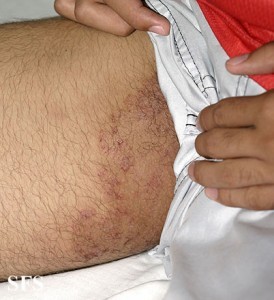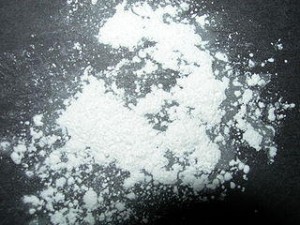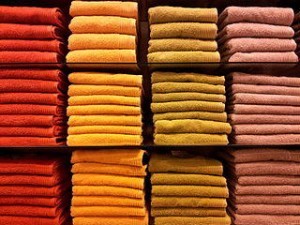Ways To Get Rid Of Groin Ringworm (Fungus)
Fungal infections of the skin are common dermatological problems throughout the world. Most skin fungal infections are superficial with the fungi never consuming more than a few layers of the outer skin (epidermis). Although it does not pose a serious health risk, a fungal infection of the skin can lead to significant discomfort, damage and scarring (mainly abnormal pigmentation) of the skin. Two of the common areas to be infected are the feet and groin region, known casually as athlete’s foot and jock itch.
About Skin Fungi
The common names of fungal infections of the feet (tinea pedis or athlete’s foot) and groin (tinea cruris or jock itch) should not be misleading. It does not only occur on athletes. A fungal skin infection can affect any person of any age. The type of skin fungi that are responsible for the vast majority of these infections are known as dermatophytes. Less commonly, yeasts like Candida albicans can be responsible. Dermatophytes have adapted to living on the surface of human skin with specialized enzymes that consume the hard protein outer layer of the skin.
The body’s immune defenses are usually able to prevent these microbes from extending any deeper. Therefore fungal infections are very localized and do not pose the same threat as a bacterial infection. Nevertheless it should not be left untreated as it can spread and damage the skin permanently. Dermatophytes tend to produce a characteristic oval-shaped lesion with red raised borders and clear normal skin in the middle. This has led to it being referred to commonly as a ringworm. But fungi are not worms.
Eradicating Fungal Infections
Fungi thrive on dead material and the outermost layers of human skin are composed of dead protein-rich cells. Warmth, moisture and darkness are the three living conditions that are ideal for fungi. Therefore it is understandable why the feet and groin are so often affected. Shoes and underwear cover each area for long hours, sweating is common at both sites and the covered area rapidly builds up heat released from the body surface. Disrupting these three factors can therefore minimize fungal growth and eventually help with its eradication.
A fungal infection should be assessed, diagnosed and treated by a medical doctor, preferably a dermatologist. There are both topical applications and oral medication that can destroy the fungi. Some topical applications are available over-the-counter without a prescription. However, severe or persistent infections need a more aggressive approach with a combination of prescription topical applications and oral medication. There are also different lifestyle and complementary remedies that are effective in both eradicating and preventing a fungal infection.
Keep The Area Dry
Fungi thrive on moisture and the groin region provides an ideal environment in this regard. Moisture may be derived from perspiration and does not easily evaporate since the groin region is covered most of the time. Furthermore many people do not wipe the groin region thoroughly after bathing. It can be time consuming and therefore some water remains in the creases. Whether it is perspiration or water, the fungus now has one of the vital resources it needs. Keep the groin area dry by thoroughly wiping after bathing. Use an electric hair dryer if necessary but ensure that it is on a low heat setting. Drying powders can also be useful for absorbing moisture and keeping the area dry throughout the day.
Ventilate The Area
The groin region is not well ventilated as it is not socially acceptable to expose this area. Furthermore the genitalia are tucked away between the thighs thereby minimizing the flow of air over the surface. These conditions allows heat and moisture to build up which is ideal for fungal growth. The lack of direct sunlight in the area is also beneficial for fungal growth. Completely exposing the groin region for long hours in the day is not practical for most people, but this does not mean it cannot be ventilated to some degree. Opt for light clothing and underwear made of airy textiles. Take advantage of airing the region when in private and especially after bathing.
Throw Away Underwear
Fungi are very resilient microorganisms. It can withstand a range of climatic conditions and form spores to survive very harsh environments. Fungi can also adhere to clothing even after washing. If you do have a groin fungus then you should get rid of your current underwear once you start on treatment. Fungal infections are very stubborn and difficult to eradicate in some cases. By getting rid of your current underwear, you will help to prevent a recurrence. Never give the underwear that you are meant to discard. By doing so you can be transmitting the infection to others who can later re-infect you even after you have successfully eradicated the fungus.
Choose Comfortable Garments
The clothing and undergarments that you wear can play a role in fungal infections. As previously explained, certain clothing will increase the likelihood of perspiring excessively in the groin region, prevent the evaporation of perspiration and retain heat in the area. In addition tight undergarments can cause chaffing which makes the skin prone to infections. Select your clothing and underwear carefully if you have a fungal infection. Opt for light airy textiles that allows air to flow. Also ensure that your underwear fits properly. It is often better to wear a slight larger and looser underwear than very fitting ones that will lead to chaffing.
Never Share Personal Items
Some fungi have a predilection for humans, while others may be found in soil or animals but can also infect human skin. The easiest route for fungal infections to be spread is from one person to another. Transmission mainly occurs through the sharing of personal items like towels, underwear or jock straps. If you or any person in your home have a fungal infection then it is best to isolate your towels and underwear from others so that there is no risk of transmission. Remember that fungal spores can still be present even after washing and drying of these personal items so sharing should not be an option at any time.








